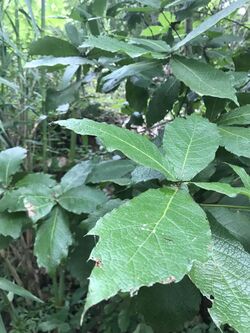Biology:Quercus rysophylla
| Quercus rysophylla | |
|---|---|

| |
| Scientific classification | |
| Kingdom: | Plantae |
| Clade: | Tracheophytes |
| Clade: | Angiosperms |
| Clade: | Eudicots |
| Clade: | Rosids |
| Order: | Fagales |
| Family: | Fagaceae |
| Genus: | Quercus |
| Subgenus: | Quercus subg. Quercus |
| Section: | Quercus sect. Lobatae |
| Species: | Q. rysophylla
|
| Binomial name | |
| Quercus rysophylla Weath.
| |
| Synonyms | |
|
Quercus rhysophylla Weath. | |
Quercus rysophylla, the loquat leaf oak, is a Mexican species of oak in the red oak section (Quercus section Lobatae). It is native to the Sierra Madre Oriental in the States of Tamaulipas, Nuevo León, San Luis Potosí, Veracruz, and Hidalgo in northeastern Mexico.[2][1]
Description
Quercus rysophylla is a large tree, up to 25 metres (82 feet) tall. It has smooth pale gray bark, which ages and becomes rough, deeply cracked and dark gray.[3] The leaves are lanceolate (lance shaped), up to 21 centimetres (8 1⁄4 inches) long.[4] It has acorns that are biennial, ripening the year after flowering.[3]
Habitat
It is normally found growing in humid canyons and on north facing slopes, in cloud forests and oak or oak–pine forests. It grows on limestone and igneous substrates.[1] It is normally found from 500–1,700 m (1,600–5,600 ft) meters elevation.[3]
The largest known population is in Cumbres de Monterrey National Park. It is also present in Sierra Gorda Biosphere Reserve.[1]
Taxonomy
It was originally published and described by Charles Alfred Weatherby in 1910.[5][6][7]
When Weatherby published his new tree, he made an error, he spelled 'rysophylla', the specific epithet refers to the Greek term ῥυσός (rhysos) meaning wrinkled and φύλλον (phyllon) for leaf. He should have used the correct spelling rhysophylla. Some botanists and publications change the epithet to rhysophylla.[8] Although, the Melbourne Code, states it should be uncorrected, therefore the original spelling, rysophylla, is deemed correct. Other incorrect spellings 'risophylla', 'rhizophylla' and 'rizophylla' can be found.[3][9]
It gained the common name 'Loquat oak' or 'loquat-leaf oak', from the superficial resemblance of the leaves in shape and texture to those of the loquat (Eriobotrya japonica).[3]
References
- ↑ 1.0 1.1 1.2 1.3 Carrero, C. (2020). "Quercus rysophylla". IUCN Red List of Threatened Species 2020: e.T30738A2795798. doi:10.2305/IUCN.UK.2020-2.RLTS.T30738A2795798.en. https://www.iucnredlist.org/species/30738/2795798. Retrieved 15 November 2021.
- ↑ Tropicos, specimen listing for Quercus rysophylla Weath.
- ↑ 3.0 3.1 3.2 3.3 3.4 Coombes, Allen James (July 2016). "Tree of the Year: Quercus rysophylla Weatherby". https://www.researchgate.net/publication/305481388.
- ↑ Weatherby, Charles Alfred 1924. Proceedings of the American Academy of Arts and Sciences 45(17): 423–424 description in Latin, commentary in English
- ↑ "Fagaceae Quercus rysophylla Weath.". ipni.org. http://www.ipni.org/ipni/idPlantNameSearch.do?id=216365-2.
- ↑ "Quercus rysophylla". The Plant List. Royal Botanic Gardens (Kew). http://www.theplantlist.org/tpl1.1/search?q=Quercus+rysophylla. Retrieved 27 December 2017.
- ↑ "Proceedings of the American Academy of Arts and Sciences", Boston, MA, Vol. 45, p. 423.
- ↑ "Quercus rhysophylla loquat oak". rhs.org.uk. https://www.rhs.org.uk/Plants/135006/Loquat-oak/Details.
- ↑ "The Plant of the Week". floresflowers.com. https://www.floresflowers.com/PlantWeek.html.
External links
Wikidata ☰ Q5502745 entry
 |


